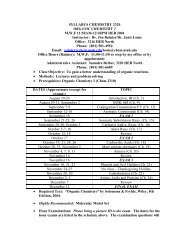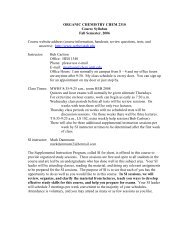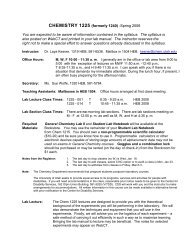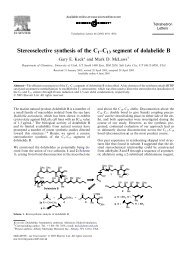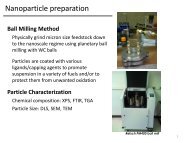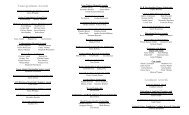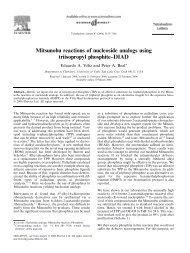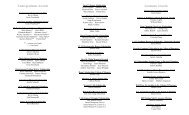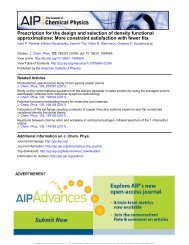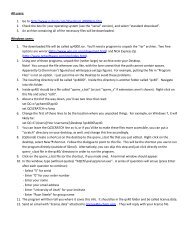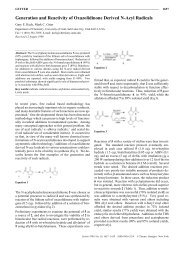Peptide Quinoline Conjugates: A New Class of RNA-Binding ...
Peptide Quinoline Conjugates: A New Class of RNA-Binding ...
Peptide Quinoline Conjugates: A New Class of RNA-Binding ...
Create successful ePaper yourself
Turn your PDF publications into a flip-book with our unique Google optimized e-Paper software.
<strong>Peptide</strong> <strong>Quinoline</strong> <strong>Conjugates</strong>: A <strong>New</strong><br />
<strong>Class</strong> <strong>of</strong> <strong>RNA</strong>-<strong>Binding</strong> Molecules<br />
ORGANIC<br />
LETTERS<br />
2004<br />
Vol. 6, No. 1<br />
63-66<br />
Malathy Krishnamurthy, Barry D. Gooch, and Peter A. Beal*<br />
Department <strong>of</strong> Chemistry, UniVersity <strong>of</strong> Utah, Salt Lake City, Utah 84112-0850<br />
beal@chemistry.utah.edu<br />
Received October 27, 2003<br />
ABSTRACT<br />
A synthesis <strong>of</strong> 4,8-disubstituted 2-phenylquinoline amino acids is reported with the incorporation <strong>of</strong> one example into a peptide by solidphase<br />
synthesis. The phenylquinoline-containing peptide binds an <strong>RNA</strong> target with nanomolar affinity (K D ) 208 nM). The strategy can be<br />
used to prepare a variety <strong>of</strong> 2-substituted quinoline amino acids for alteration <strong>of</strong> affinity in intercalator peptides. Since quinolones represent<br />
an important class <strong>of</strong> antibacterials, these compounds may be useful in the discovery <strong>of</strong> new antibacterial agents.<br />
The appreciation <strong>of</strong> <strong>RNA</strong> as a target for new antibiotic drugs<br />
has increased interest in the development <strong>of</strong> low molecular<br />
weight compounds that bind <strong>RNA</strong> selectively. 1-5 Early<br />
studies indicate the major challenge in developing small<br />
molecule ligands for <strong>RNA</strong> is making them specific for a<br />
given <strong>RNA</strong> target. 6,7 Compounds that bind an <strong>RNA</strong> structure<br />
and make contacts at several sites using a variety <strong>of</strong> binding<br />
modes (e.g., π-stacking, H-bonding, van der Waals contacts,<br />
charge-charge interactions, etc.) will likely be the most<br />
selective, since other <strong>RNA</strong>s will not have the requisite<br />
arrangement <strong>of</strong> complementary functional groups. A particularly<br />
attractive binding mechanism that allows for<br />
multiple points <strong>of</strong> contact between ligand and <strong>RNA</strong> is<br />
threading intercalation. 8-11 Threading intercalation involves<br />
(1) Gallego, J.; Varani, G. Acc. Chem. Res. 2001, 34, 836-843.<br />
(2) Hermann, T.; Westh<strong>of</strong>, E. Curr. Opin. Biotechnol. 1998, 9, 66-73.<br />
(3) Pearson, N. D.; Prescott, C. D. Chem. Biol. 1997, 4, 409-414.<br />
(4) Wilson, W. D.; Li, K. Curr. Med. Chem. 2000, 7, 73-98.<br />
(5) Xavier, K. A.; Eder, P. S.; Giordano, T. TIBTECH 2000, 18, 349-<br />
356.<br />
(6) Carlson, C. B.; Spanggord, R. J.; Beal, P. A. ChemBioChem 2002,<br />
3, 859-865.<br />
(7) Luedtke, N. W.; Liu, Q.; Tor, Y. Biochemistry 2003, 42, 11391-<br />
11403.<br />
(8) Caceres-Cortes, J.; Sugiyama, H.; Ikudome, K.; Saito, I.; Wang, A.<br />
H.-J. Biochemistry 1997, 36, 9995-10005.<br />
(9) Guelev, V.; Lee, J.; Ward, J.; Sorey, S.; H<strong>of</strong>fman, D. W.; Iverson,<br />
B. L. Chem. Biol. 2001, 8, 415-425.<br />
insertion <strong>of</strong> an intercalator between base pairs <strong>of</strong> a nucleic<br />
acid duplex and localization <strong>of</strong> distinguishable substituents<br />
on the heterocycle in opposite grooves <strong>of</strong> the helix. We have<br />
reported a solid-phase synthesis approach to threading<br />
intercalator peptides with an acridine chromophore introduced<br />
into the peptide backbone such that the N- and<br />
C-termini lie in opposite grooves in an intercalation complex.<br />
12 This design allows the groove-localized substituents<br />
to be varied via combinatorial peptide synthesis.<br />
Importantly, for selective binding to be achieved, the<br />
relative contribution to the binding affinity <strong>of</strong> functional<br />
groups in the ligand must be balanced to prevent nonspecific<br />
binding to imperfectly matched sites. In the case <strong>of</strong> threading<br />
intercalators, if the affinity <strong>of</strong> the intercalating group is too<br />
large relative to other groups in the ligand, additional nucleic<br />
acids with accessible π-stacking surfaces may also be bound<br />
with similar affinities. Thus, controlling the binding affinity<br />
<strong>of</strong> the intercalating group will become increasingly important<br />
as threading intercalators are developed for selective <strong>RNA</strong><br />
binding. In this Letter, we describe a new threading inter-<br />
(10) Jourdan, M.; Garcia, J.; Lhomme, J. Biochemistry 1999, 38, 14205-<br />
14213.<br />
(11) Liaw, Y.-C.; Gao, Y.-G.; Robinson, H.; van der Marel, G. A.; van<br />
Boom, J. H.; Wang, A. H.-J. Biochemistry 1989, 28, 9913-9918.<br />
(12) Carlson, C. B.; Beal, P. A. Bioorg. Med. Chem. Lett. 2000, 10,<br />
1979-1982.<br />
10.1021/ol036094+ CCC: $27.50<br />
Published on Web 12/09/2003<br />
© 2004 American Chemical Society
Scheme 1 a<br />
a<br />
(a) (i) CH 3 SO 3 H/benzene reflux, (ii) Ph 2 O/255 °C; (b) PPh 3 /<br />
NBS/CH 3 CN reflux; (c) allyl 4-aminobenzyl-amino carbamate 12 /<br />
CH 3 CN reflux; (d) LiOH‚H 2 O/THF-H 2 O rt.<br />
Figure 1. Amino acids synthesized for incorporation into peptide<br />
quinoline conjugates via SPPS.<br />
calator design: the peptide quinoline conjugate (PQC). A<br />
solid-phase synthesis scheme is reported for the preparation<br />
<strong>of</strong> 2-phenylquinolines with peptide substituents at the 4- and<br />
8-positions. Furthermore, the ability <strong>of</strong> the intercalator to<br />
π-stack can be readily modulated by altering the polarity <strong>of</strong><br />
the π-aromatic system through substitution <strong>of</strong> the 2-phenyl<br />
group. The <strong>RNA</strong> binding properties <strong>of</strong> a prototypical PQC<br />
are also evaluated.<br />
To generate quinoline-based threading intercalator peptides,<br />
we prepared compounds 1 and 2, each with an Allocprotected<br />
4-aminobenzylamine appendage at the quinoline<br />
4-position and a carboxyl group at the 8-position (Figure<br />
1). A phenyl group is present at position 2, since 2-phenylquinolines<br />
are known intercalators. Furthermore, the π-stacking<br />
ability <strong>of</strong> the 2-phenyl group present in compound 2 is<br />
modulated by the polarizing nitro substituent. In analogy to<br />
the acridine-containing amino acid previously described by<br />
us, these compounds are likely to be compatible with solidphase<br />
peptide synthesis (SPPS) with Fmoc-protected amino<br />
acids. 12,13 2-Phenyl-4-aminoquinoline derivatives and 2-<br />
phenylquinoline-8-carboxamides have been shown to bind<br />
nucleic acids by intercalation. 14,15 However, there are no prior<br />
reports <strong>of</strong> 2-phenylquinolines simultaneously modified at<br />
positions 4 and 8 in this manner. This substitution pattern<br />
creates molecules with substituents on opposite edges <strong>of</strong> the<br />
quinoline heterocycle and, thus, potential threading intercalators.<br />
Our synthesis <strong>of</strong> 1 begins with 8-methoxycarbonyl-2-<br />
phenyl-4(1H)-quinolone 3, which is prepared as described<br />
by Denny via condensation <strong>of</strong> methyl anthranilate and<br />
ethylbenzoyl acetate followed by thermal cyclization <strong>of</strong> the<br />
condensation product (Scheme 1). 16 Bromination <strong>of</strong> 3 by<br />
treatment with triphenylphosphine and N-bromosuccinimide<br />
in acetonitrile gave 4 in good yield. 17 Given our recent<br />
experience with simple substitution reactions involving<br />
acetyl-protected bromopurine ribonucleosides, we anticipated<br />
that bromoquinoline 4 would react selectively at the 4-position<br />
under mild conditions with nitrogen nucleophiles, even<br />
(13) Carlson, C. B.; Beal, P. A. Org. Lett. 2000, 2, 1465-1468.<br />
(14) Zhou, M.; Janda, L.; Nguyen, J.; Strekowski, L.; Wilson, W. D.<br />
Biopolymers 1994, 34, 61-73.<br />
(15) Denny, W. A.; Atwell, G. J.; Baguley, B. C. Anti-Cancer Drug Des.<br />
1987, 2, 263-270.<br />
(16) Atwell, G. J.; Baguley, B. C.; Denny, W. A. J. Med. Chem. 1989,<br />
32, 396-401.<br />
(17) Sugimoto, O.; Mori, M.; Tanji, K.-i. Tetrahedron Lett. 1999, 40,<br />
7477-7478.<br />
weakly nucleophilic aniline derivatives. 18 Indeed, compound<br />
4 is readily converted to 4-anilino derivative 5 in acetonitrile<br />
at reflux in excellent yield. Saponification <strong>of</strong> the methyl ester<br />
gave N-Alloc-protected amino acid 1 ready for activation<br />
and coupling in SPPS. This same strategy can be extended<br />
to prepare quinoline amino acids with a substituted phenyl<br />
group <strong>of</strong> varying π-system polarity, as indicated by the<br />
synthesis <strong>of</strong> nitro compound 2 (Scheme 1). The synthesis <strong>of</strong><br />
2 was initiated by condensation <strong>of</strong> ethyl(4-nitrobenzoyl)-<br />
acetate and methylanthranilate followed by cyclization to<br />
give quinolone 6. Bromination to 7, substitution with Allocprotected<br />
amine to give 8, and saponification produced 2-(4-<br />
nitrophenyl)quinoline amino acid 2.<br />
To demonstrate that these 2-phenylquinoline amino acids<br />
can be used in SPPS, the peptide sequence N-Abu-Ser-Val-<br />
PheQ-Arg-C was prepared, where Abu is aminobutyric acid<br />
and PheQ refers to the 4,8-disubstituted 2-phenylquinoline<br />
amino acid. Amino acid 1 was activated as the N-hydroxysuccinimide<br />
(NHS) ester and coupled to the solid-supported<br />
primary amino group <strong>of</strong> Pbf-protected arginine. The Alloc<br />
group was removed using Pd(PPh 3 ) 4 /PhSiH 3 in CH 2 Cl 2 at<br />
room temperature for 30 min to reveal the benzylamine for<br />
subsequent elaboration by peptide synthesis. 19 The additional<br />
amino acid residues were introduced via standard protocols.<br />
Upon completion <strong>of</strong> the solid-phase synthesis, the peptide<br />
was released and the side chains were deprotected by<br />
treatment <strong>of</strong> the resin with TFA/TIS/PhOH/H 2 O (88:5:5:2)<br />
to give peptide 9 (Figure 2). The structure <strong>of</strong> 9 was confirmed<br />
by fast atom bombardment and electrospray ionization mass<br />
spectrometry.<br />
The threading peptide N-Abu-Ser-Val-Acr-Arg-C (10),<br />
where Acr is a 4,9-disubstituted acridine amino acid, binds<br />
(18) Véliz, E. A.; Beal, P. A. J. Org. Chem. 2001, 66, 8592-8598.<br />
(19) Thieriet, N.; Alsina, J.; Giralt, E.; Guibé, F.; Albericio, F.<br />
Tetrahedron Lett. 1997, 38, 7275-7278.<br />
64 Org. Lett., Vol. 6, No. 1, 2004
Figure 2. (a) Quantitative ribonuclease V1 footprinting with AbuSVPheQR (9) and an in vitro selected <strong>RNA</strong>. Shown is a partial storage<br />
phosphor autoradiogram <strong>of</strong> a 10.5% denaturing polyacrylamide gel separating 5′- 32 P-labeled <strong>RNA</strong> cleavage products. First three lanes,<br />
from left to right: Alone, <strong>RNA</strong> in buffer only; OH, alkaline hydrolysis; T1, RNase T1. The remaining lanes contain increasing concentrations<br />
<strong>of</strong> 9 (from left to right, 0, 0.001, 0.01, 0.1, 1, 10, 50 µM) in the presence <strong>of</strong> RNase V1. The footprinted region (C42-A46) is bracketed,<br />
as well as the constant V1-dependent nucleotide (U54) used to normalize for differential loading <strong>of</strong> the gel. (b) Secondary structure <strong>of</strong><br />
nucleotides C22-G56 <strong>of</strong> the <strong>RNA</strong> aptamer as predicted by mfold. 20,21 The binding site for 9 is indicated. (c) Plot <strong>of</strong> fraction bound versus<br />
concentration <strong>of</strong> 9 (red) and 10 22 (blue) as determined by RNase V1 footprinting.<br />
preferentially to base-paired 5′-CpG-3′ sites in <strong>RNA</strong> flanked<br />
by non-Watson-Crick structural elements (Figure 2). 22 We<br />
determined the extent to which 9 bound to an in vitro selected<br />
<strong>RNA</strong> containing such a site using ribonuclease V1 footprinting<br />
(Figure 2a). <strong>Peptide</strong> 9 bound this stem-loop structure to<br />
give a footprint similar to that observed with 10, indicating<br />
peptides 9 and 10 bind the same site on this <strong>RNA</strong>. 22<br />
<strong>Quinoline</strong> peptide 9 binds with a K D ) 208 nM, whereas<br />
acridine peptide 10 bound with a K D ) 20 nM (Figure 2c).<br />
Interestingly, this difference in affinity is similar to that<br />
observed for a 2-phenylquinoline substitution for acridine<br />
in a known DNA intercalator. 15 Thus, the decreased binding<br />
(20) Mathews, D. H.; Sabrina, J.; Zuker, M.; Turner, D. H. J. Mol. Biol.<br />
1999, 288, 911-940.<br />
(21) Zuker, M.; Mathews, D. H.; Turner, D. H. Algorithms and<br />
Thermodynamics for <strong>RNA</strong> Secondary Structure Prediction: A Practical<br />
Guide in <strong>RNA</strong> Biochemistry and Biotechnology; Kluwer Academic Publishers:<br />
Dordrecht, 1999.<br />
(22) Carlson, C. B.; Vuyisich, M.; Gooch, B. D.; Beal, P. A. Chem. Biol.<br />
2003, 10, 663-672.<br />
affinity <strong>of</strong> peptide 9 compared to that <strong>of</strong> 10 likely arises from<br />
a decrease in efficacy <strong>of</strong> intercalation.<br />
In summary, the synthesis <strong>of</strong> 2-phenylquinoline amino<br />
acids compatible with SPPS with Fmoc-protected amino<br />
acids has been accomplished. A peptide prepared with a<br />
2-phenylquinoline amino acid binds an <strong>RNA</strong> stem-loop<br />
structure at the same site as the corresponding acridine-based<br />
threading peptide with an approximately 10-fold lower<br />
affinity. The strategy developed is applicable to the preparation<br />
<strong>of</strong> a variety <strong>of</strong> 2-substituted quinoline amino acids for<br />
systematic alteration <strong>of</strong> intercalator affinity in threading<br />
intercalator peptides. Since quinolones represent an important<br />
class <strong>of</strong> antibacterials, these compounds (conjugates and/or<br />
libraries) may also be useful in the discovery <strong>of</strong> new<br />
antibacterial agents.<br />
Acknowledgment. P.A.B. acknowledges support from the<br />
NIH (AI-49062) and a Camille Dreyfus Teacher Scholar<br />
Org. Lett., Vol. 6, No. 1, 2004 65
Award. B.D.G. was supported by a National Institutes <strong>of</strong><br />
Health training grant (GM-08573).<br />
Supporting Information Available: Experimental procedures<br />
and NMR and mass spectral data for compounds<br />
listed in Scheme 1 and general procedure for the synthesis<br />
<strong>of</strong> 9 and its biochemical analysis, including <strong>RNA</strong> synthesis<br />
and labeling and ribonuclease footprining. This material<br />
is available free <strong>of</strong> charge via the Internet at<br />
http://pubs.acs.org.<br />
OL036094+<br />
66 Org. Lett., Vol. 6, No. 1, 2004




